Financial Fraud: Investigation, Techniques and Dispute Resolution
VerifiedAdded on 2020/12/31
|14
|5118
|85
Report
AI Summary
This report delves into the multifaceted world of financial fraud, encompassing its deterrence, detection, and investigation, with a comparative analysis between Australia and Estonia. It explores various techniques employed in forensic accounting, including forensic data analysis and the application of the fraud triangle theory, using a case study of Leighton Contractors to illustrate the practical application of these concepts. The report further examines dispute resolution engagement, highlighting the techniques used to achieve sustainable outcomes and recover financial and non-financial resources. The investigation also explores the role of expert witnesses in forensic accounting engagements, emphasizing their contributions to legal proceedings and the presentation of complex financial information. The report covers Commonwealth Fraud Control framework, auditing standards, and government structures in Australia to control financial statement frauds.

FINANCIAL FRAUD
Paraphrase This Document
Need a fresh take? Get an instant paraphrase of this document with our AI Paraphraser
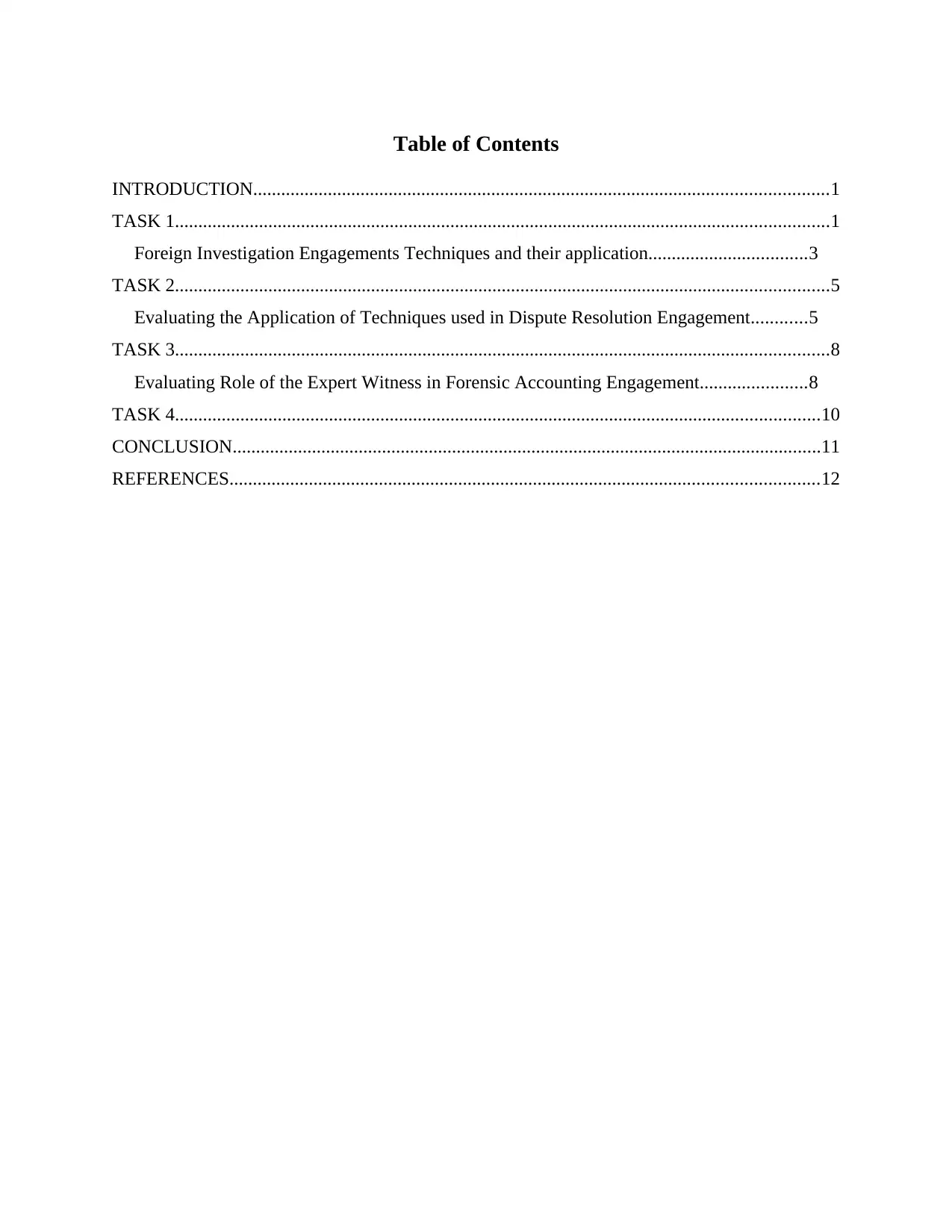
Table of Contents
INTRODUCTION...........................................................................................................................1
TASK 1............................................................................................................................................1
Foreign Investigation Engagements Techniques and their application..................................3
TASK 2............................................................................................................................................5
Evaluating the Application of Techniques used in Dispute Resolution Engagement............5
TASK 3............................................................................................................................................8
Evaluating Role of the Expert Witness in Forensic Accounting Engagement.......................8
TASK 4..........................................................................................................................................10
CONCLUSION..............................................................................................................................11
REFERENCES..............................................................................................................................12
INTRODUCTION...........................................................................................................................1
TASK 1............................................................................................................................................1
Foreign Investigation Engagements Techniques and their application..................................3
TASK 2............................................................................................................................................5
Evaluating the Application of Techniques used in Dispute Resolution Engagement............5
TASK 3............................................................................................................................................8
Evaluating Role of the Expert Witness in Forensic Accounting Engagement.......................8
TASK 4..........................................................................................................................................10
CONCLUSION..............................................................................................................................11
REFERENCES..............................................................................................................................12
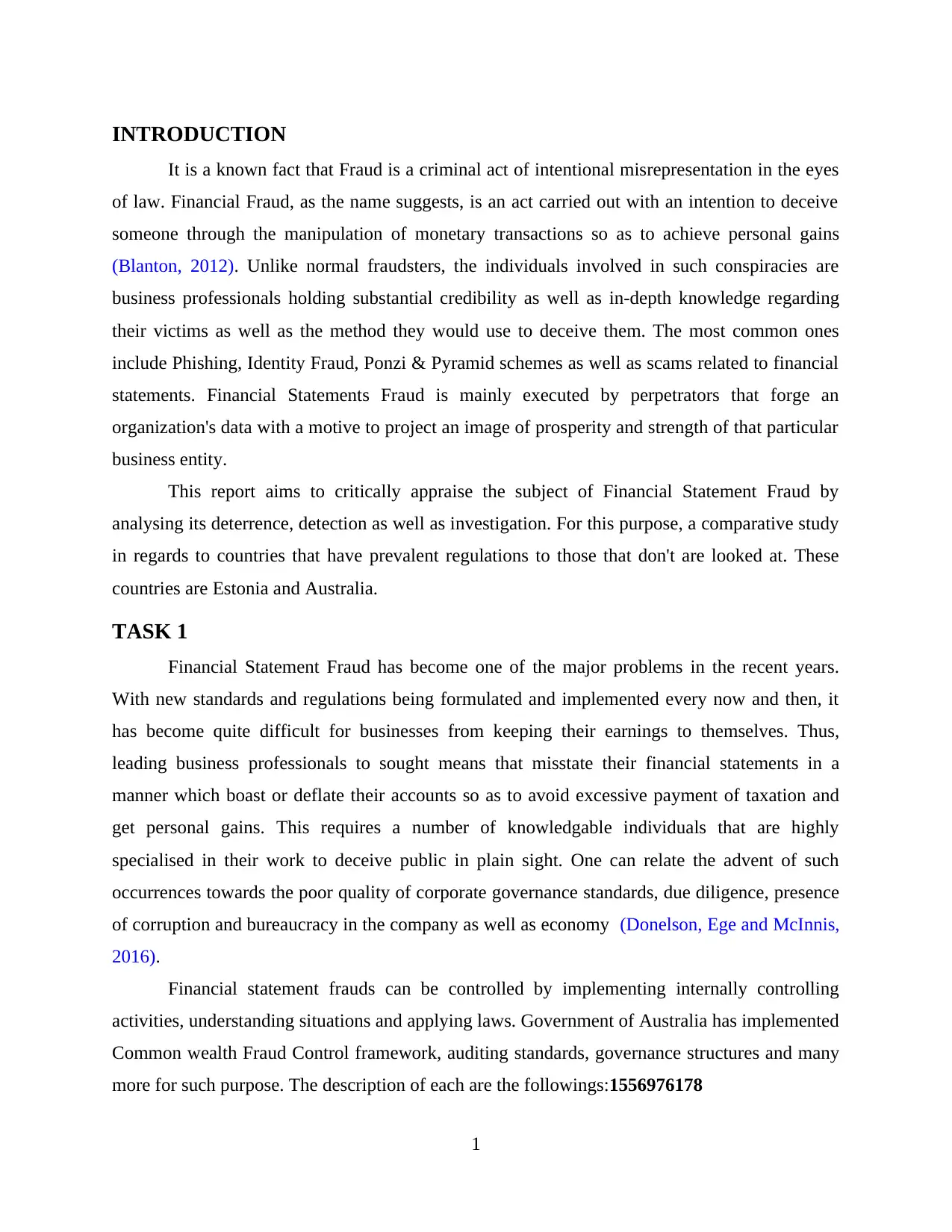
INTRODUCTION
It is a known fact that Fraud is a criminal act of intentional misrepresentation in the eyes
of law. Financial Fraud, as the name suggests, is an act carried out with an intention to deceive
someone through the manipulation of monetary transactions so as to achieve personal gains
(Blanton, 2012). Unlike normal fraudsters, the individuals involved in such conspiracies are
business professionals holding substantial credibility as well as in-depth knowledge regarding
their victims as well as the method they would use to deceive them. The most common ones
include Phishing, Identity Fraud, Ponzi & Pyramid schemes as well as scams related to financial
statements. Financial Statements Fraud is mainly executed by perpetrators that forge an
organization's data with a motive to project an image of prosperity and strength of that particular
business entity.
This report aims to critically appraise the subject of Financial Statement Fraud by
analysing its deterrence, detection as well as investigation. For this purpose, a comparative study
in regards to countries that have prevalent regulations to those that don't are looked at. These
countries are Estonia and Australia.
TASK 1
Financial Statement Fraud has become one of the major problems in the recent years.
With new standards and regulations being formulated and implemented every now and then, it
has become quite difficult for businesses from keeping their earnings to themselves. Thus,
leading business professionals to sought means that misstate their financial statements in a
manner which boast or deflate their accounts so as to avoid excessive payment of taxation and
get personal gains. This requires a number of knowledgable individuals that are highly
specialised in their work to deceive public in plain sight. One can relate the advent of such
occurrences towards the poor quality of corporate governance standards, due diligence, presence
of corruption and bureaucracy in the company as well as economy (Donelson, Ege and McInnis,
2016).
Financial statement frauds can be controlled by implementing internally controlling
activities, understanding situations and applying laws. Government of Australia has implemented
Common wealth Fraud Control framework, auditing standards, governance structures and many
more for such purpose. The description of each are the followings:1556976178
1
It is a known fact that Fraud is a criminal act of intentional misrepresentation in the eyes
of law. Financial Fraud, as the name suggests, is an act carried out with an intention to deceive
someone through the manipulation of monetary transactions so as to achieve personal gains
(Blanton, 2012). Unlike normal fraudsters, the individuals involved in such conspiracies are
business professionals holding substantial credibility as well as in-depth knowledge regarding
their victims as well as the method they would use to deceive them. The most common ones
include Phishing, Identity Fraud, Ponzi & Pyramid schemes as well as scams related to financial
statements. Financial Statements Fraud is mainly executed by perpetrators that forge an
organization's data with a motive to project an image of prosperity and strength of that particular
business entity.
This report aims to critically appraise the subject of Financial Statement Fraud by
analysing its deterrence, detection as well as investigation. For this purpose, a comparative study
in regards to countries that have prevalent regulations to those that don't are looked at. These
countries are Estonia and Australia.
TASK 1
Financial Statement Fraud has become one of the major problems in the recent years.
With new standards and regulations being formulated and implemented every now and then, it
has become quite difficult for businesses from keeping their earnings to themselves. Thus,
leading business professionals to sought means that misstate their financial statements in a
manner which boast or deflate their accounts so as to avoid excessive payment of taxation and
get personal gains. This requires a number of knowledgable individuals that are highly
specialised in their work to deceive public in plain sight. One can relate the advent of such
occurrences towards the poor quality of corporate governance standards, due diligence, presence
of corruption and bureaucracy in the company as well as economy (Donelson, Ege and McInnis,
2016).
Financial statement frauds can be controlled by implementing internally controlling
activities, understanding situations and applying laws. Government of Australia has implemented
Common wealth Fraud Control framework, auditing standards, governance structures and many
more for such purpose. The description of each are the followings:1556976178
1
⊘ This is a preview!⊘
Do you want full access?
Subscribe today to unlock all pages.

Trusted by 1+ million students worldwide
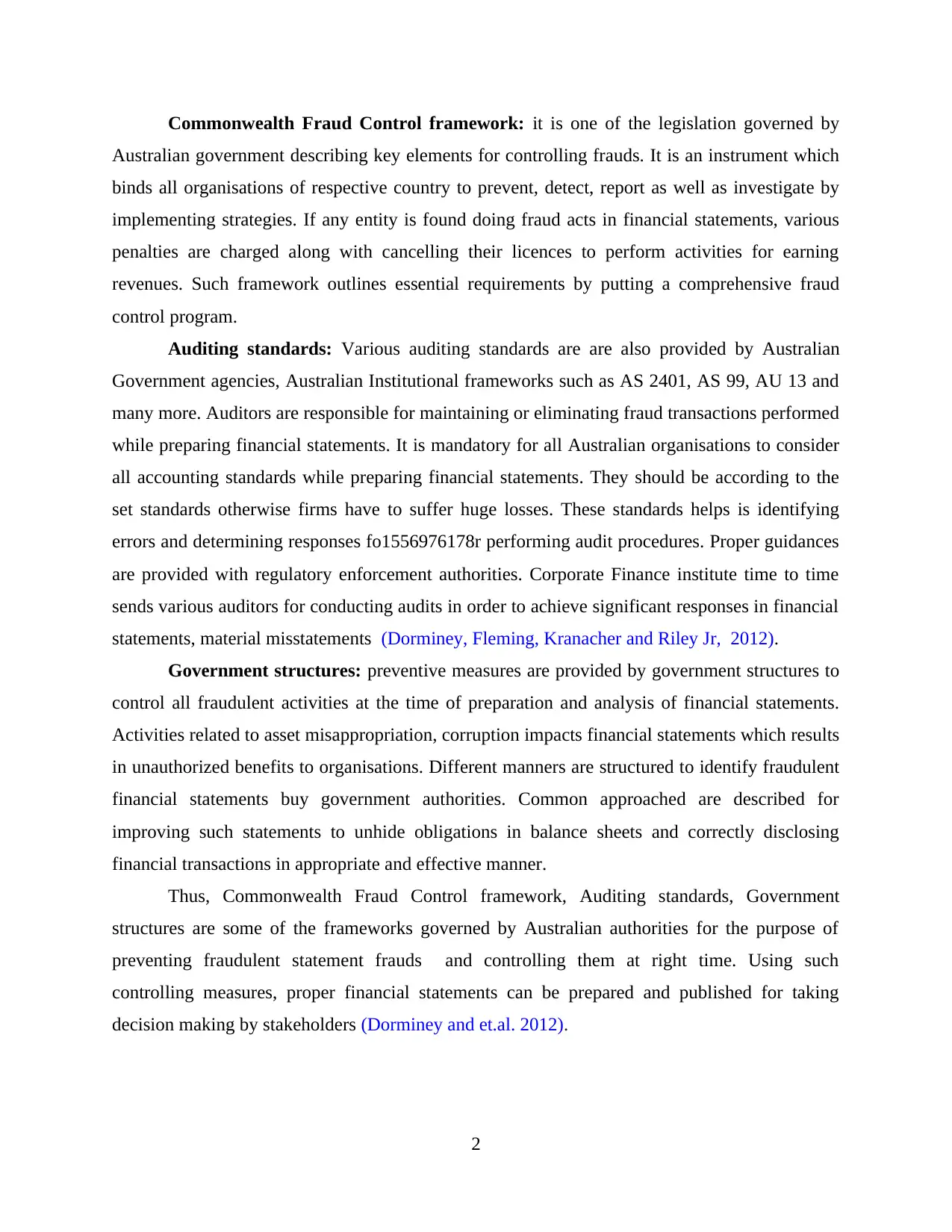
Commonwealth Fraud Control framework: it is one of the legislation governed by
Australian government describing key elements for controlling frauds. It is an instrument which
binds all organisations of respective country to prevent, detect, report as well as investigate by
implementing strategies. If any entity is found doing fraud acts in financial statements, various
penalties are charged along with cancelling their licences to perform activities for earning
revenues. Such framework outlines essential requirements by putting a comprehensive fraud
control program.
Auditing standards: Various auditing standards are are also provided by Australian
Government agencies, Australian Institutional frameworks such as AS 2401, AS 99, AU 13 and
many more. Auditors are responsible for maintaining or eliminating fraud transactions performed
while preparing financial statements. It is mandatory for all Australian organisations to consider
all accounting standards while preparing financial statements. They should be according to the
set standards otherwise firms have to suffer huge losses. These standards helps is identifying
errors and determining responses fo1556976178r performing audit procedures. Proper guidances
are provided with regulatory enforcement authorities. Corporate Finance institute time to time
sends various auditors for conducting audits in order to achieve significant responses in financial
statements, material misstatements (Dorminey, Fleming, Kranacher and Riley Jr, 2012).
Government structures: preventive measures are provided by government structures to
control all fraudulent activities at the time of preparation and analysis of financial statements.
Activities related to asset misappropriation, corruption impacts financial statements which results
in unauthorized benefits to organisations. Different manners are structured to identify fraudulent
financial statements buy government authorities. Common approached are described for
improving such statements to unhide obligations in balance sheets and correctly disclosing
financial transactions in appropriate and effective manner.
Thus, Commonwealth Fraud Control framework, Auditing standards, Government
structures are some of the frameworks governed by Australian authorities for the purpose of
preventing fraudulent statement frauds and controlling them at right time. Using such
controlling measures, proper financial statements can be prepared and published for taking
decision making by stakeholders (Dorminey and et.al. 2012).
2
Australian government describing key elements for controlling frauds. It is an instrument which
binds all organisations of respective country to prevent, detect, report as well as investigate by
implementing strategies. If any entity is found doing fraud acts in financial statements, various
penalties are charged along with cancelling their licences to perform activities for earning
revenues. Such framework outlines essential requirements by putting a comprehensive fraud
control program.
Auditing standards: Various auditing standards are are also provided by Australian
Government agencies, Australian Institutional frameworks such as AS 2401, AS 99, AU 13 and
many more. Auditors are responsible for maintaining or eliminating fraud transactions performed
while preparing financial statements. It is mandatory for all Australian organisations to consider
all accounting standards while preparing financial statements. They should be according to the
set standards otherwise firms have to suffer huge losses. These standards helps is identifying
errors and determining responses fo1556976178r performing audit procedures. Proper guidances
are provided with regulatory enforcement authorities. Corporate Finance institute time to time
sends various auditors for conducting audits in order to achieve significant responses in financial
statements, material misstatements (Dorminey, Fleming, Kranacher and Riley Jr, 2012).
Government structures: preventive measures are provided by government structures to
control all fraudulent activities at the time of preparation and analysis of financial statements.
Activities related to asset misappropriation, corruption impacts financial statements which results
in unauthorized benefits to organisations. Different manners are structured to identify fraudulent
financial statements buy government authorities. Common approached are described for
improving such statements to unhide obligations in balance sheets and correctly disclosing
financial transactions in appropriate and effective manner.
Thus, Commonwealth Fraud Control framework, Auditing standards, Government
structures are some of the frameworks governed by Australian authorities for the purpose of
preventing fraudulent statement frauds and controlling them at right time. Using such
controlling measures, proper financial statements can be prepared and published for taking
decision making by stakeholders (Dorminey and et.al. 2012).
2
Paraphrase This Document
Need a fresh take? Get an instant paraphrase of this document with our AI Paraphraser
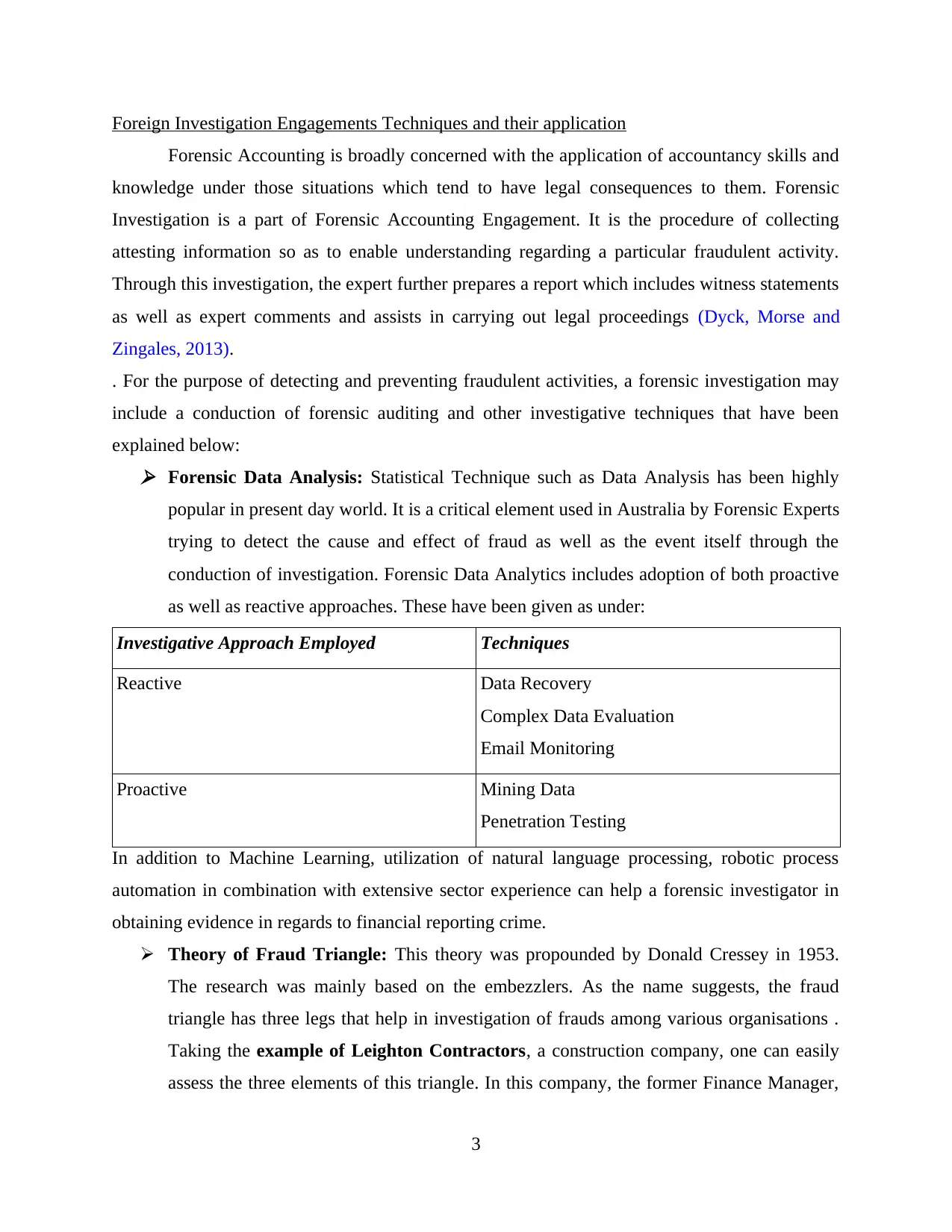
Foreign Investigation Engagements Techniques and their application
Forensic Accounting is broadly concerned with the application of accountancy skills and
knowledge under those situations which tend to have legal consequences to them. Forensic
Investigation is a part of Forensic Accounting Engagement. It is the procedure of collecting
attesting information so as to enable understanding regarding a particular fraudulent activity.
Through this investigation, the expert further prepares a report which includes witness statements
as well as expert comments and assists in carrying out legal proceedings (Dyck, Morse and
Zingales, 2013).
. For the purpose of detecting and preventing fraudulent activities, a forensic investigation may
include a conduction of forensic auditing and other investigative techniques that have been
explained below: Forensic Data Analysis: Statistical Technique such as Data Analysis has been highly
popular in present day world. It is a critical element used in Australia by Forensic Experts
trying to detect the cause and effect of fraud as well as the event itself through the
conduction of investigation. Forensic Data Analytics includes adoption of both proactive
as well as reactive approaches. These have been given as under:
Investigative Approach Employed Techniques
Reactive Data Recovery
Complex Data Evaluation
Email Monitoring
Proactive Mining Data
Penetration Testing
In addition to Machine Learning, utilization of natural language processing, robotic process
automation in combination with extensive sector experience can help a forensic investigator in
obtaining evidence in regards to financial reporting crime.
Theory of Fraud Triangle: This theory was propounded by Donald Cressey in 1953.
The research was mainly based on the embezzlers. As the name suggests, the fraud
triangle has three legs that help in investigation of frauds among various organisations .
Taking the example of Leighton Contractors, a construction company, one can easily
assess the three elements of this triangle. In this company, the former Finance Manager,
3
Forensic Accounting is broadly concerned with the application of accountancy skills and
knowledge under those situations which tend to have legal consequences to them. Forensic
Investigation is a part of Forensic Accounting Engagement. It is the procedure of collecting
attesting information so as to enable understanding regarding a particular fraudulent activity.
Through this investigation, the expert further prepares a report which includes witness statements
as well as expert comments and assists in carrying out legal proceedings (Dyck, Morse and
Zingales, 2013).
. For the purpose of detecting and preventing fraudulent activities, a forensic investigation may
include a conduction of forensic auditing and other investigative techniques that have been
explained below: Forensic Data Analysis: Statistical Technique such as Data Analysis has been highly
popular in present day world. It is a critical element used in Australia by Forensic Experts
trying to detect the cause and effect of fraud as well as the event itself through the
conduction of investigation. Forensic Data Analytics includes adoption of both proactive
as well as reactive approaches. These have been given as under:
Investigative Approach Employed Techniques
Reactive Data Recovery
Complex Data Evaluation
Email Monitoring
Proactive Mining Data
Penetration Testing
In addition to Machine Learning, utilization of natural language processing, robotic process
automation in combination with extensive sector experience can help a forensic investigator in
obtaining evidence in regards to financial reporting crime.
Theory of Fraud Triangle: This theory was propounded by Donald Cressey in 1953.
The research was mainly based on the embezzlers. As the name suggests, the fraud
triangle has three legs that help in investigation of frauds among various organisations .
Taking the example of Leighton Contractors, a construction company, one can easily
assess the three elements of this triangle. In this company, the former Finance Manager,
3
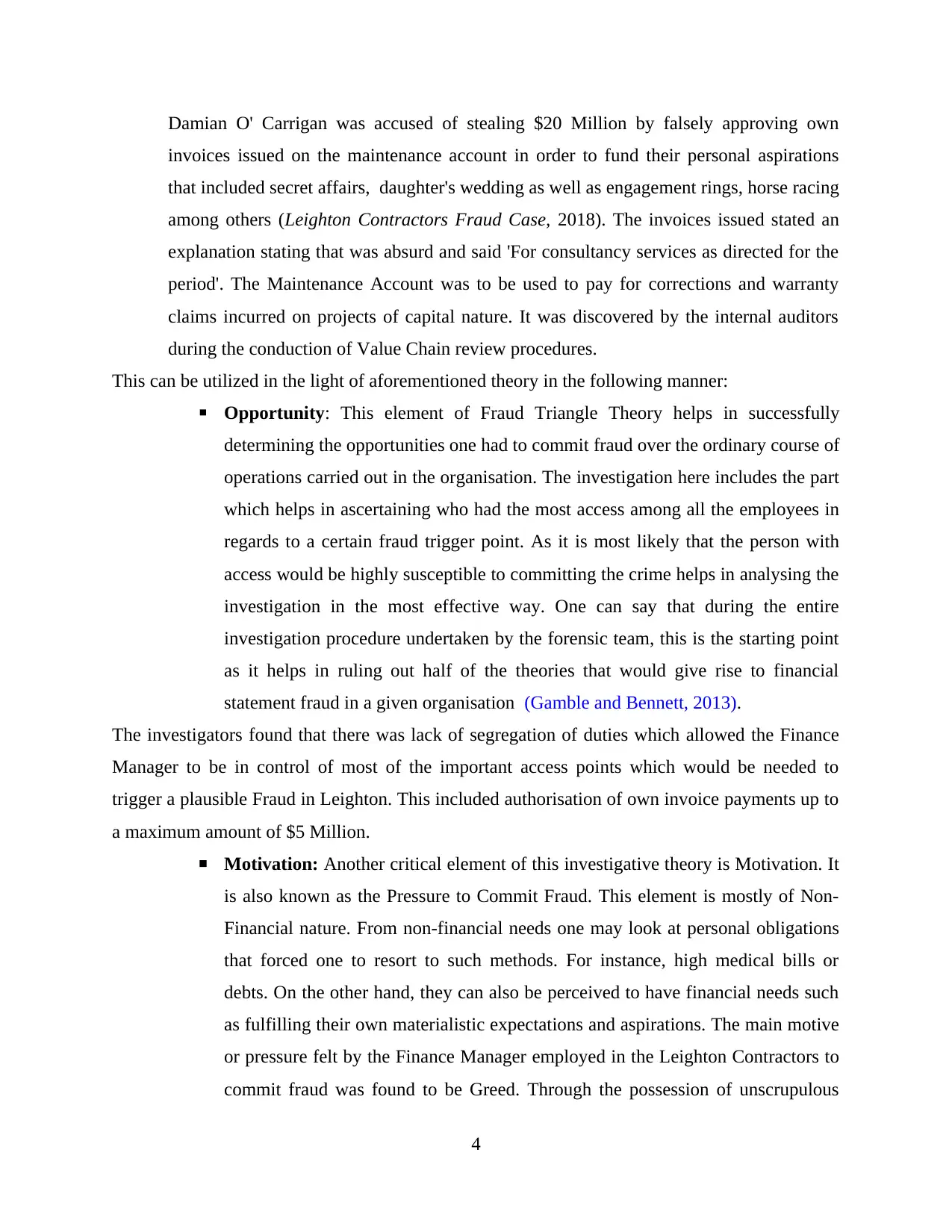
Damian O' Carrigan was accused of stealing $20 Million by falsely approving own
invoices issued on the maintenance account in order to fund their personal aspirations
that included secret affairs, daughter's wedding as well as engagement rings, horse racing
among others (Leighton Contractors Fraud Case, 2018). The invoices issued stated an
explanation stating that was absurd and said 'For consultancy services as directed for the
period'. The Maintenance Account was to be used to pay for corrections and warranty
claims incurred on projects of capital nature. It was discovered by the internal auditors
during the conduction of Value Chain review procedures.
This can be utilized in the light of aforementioned theory in the following manner:
▪ Opportunity: This element of Fraud Triangle Theory helps in successfully
determining the opportunities one had to commit fraud over the ordinary course of
operations carried out in the organisation. The investigation here includes the part
which helps in ascertaining who had the most access among all the employees in
regards to a certain fraud trigger point. As it is most likely that the person with
access would be highly susceptible to committing the crime helps in analysing the
investigation in the most effective way. One can say that during the entire
investigation procedure undertaken by the forensic team, this is the starting point
as it helps in ruling out half of the theories that would give rise to financial
statement fraud in a given organisation (Gamble and Bennett, 2013).
The investigators found that there was lack of segregation of duties which allowed the Finance
Manager to be in control of most of the important access points which would be needed to
trigger a plausible Fraud in Leighton. This included authorisation of own invoice payments up to
a maximum amount of $5 Million.
▪ Motivation: Another critical element of this investigative theory is Motivation. It
is also known as the Pressure to Commit Fraud. This element is mostly of Non-
Financial nature. From non-financial needs one may look at personal obligations
that forced one to resort to such methods. For instance, high medical bills or
debts. On the other hand, they can also be perceived to have financial needs such
as fulfilling their own materialistic expectations and aspirations. The main motive
or pressure felt by the Finance Manager employed in the Leighton Contractors to
commit fraud was found to be Greed. Through the possession of unscrupulous
4
invoices issued on the maintenance account in order to fund their personal aspirations
that included secret affairs, daughter's wedding as well as engagement rings, horse racing
among others (Leighton Contractors Fraud Case, 2018). The invoices issued stated an
explanation stating that was absurd and said 'For consultancy services as directed for the
period'. The Maintenance Account was to be used to pay for corrections and warranty
claims incurred on projects of capital nature. It was discovered by the internal auditors
during the conduction of Value Chain review procedures.
This can be utilized in the light of aforementioned theory in the following manner:
▪ Opportunity: This element of Fraud Triangle Theory helps in successfully
determining the opportunities one had to commit fraud over the ordinary course of
operations carried out in the organisation. The investigation here includes the part
which helps in ascertaining who had the most access among all the employees in
regards to a certain fraud trigger point. As it is most likely that the person with
access would be highly susceptible to committing the crime helps in analysing the
investigation in the most effective way. One can say that during the entire
investigation procedure undertaken by the forensic team, this is the starting point
as it helps in ruling out half of the theories that would give rise to financial
statement fraud in a given organisation (Gamble and Bennett, 2013).
The investigators found that there was lack of segregation of duties which allowed the Finance
Manager to be in control of most of the important access points which would be needed to
trigger a plausible Fraud in Leighton. This included authorisation of own invoice payments up to
a maximum amount of $5 Million.
▪ Motivation: Another critical element of this investigative theory is Motivation. It
is also known as the Pressure to Commit Fraud. This element is mostly of Non-
Financial nature. From non-financial needs one may look at personal obligations
that forced one to resort to such methods. For instance, high medical bills or
debts. On the other hand, they can also be perceived to have financial needs such
as fulfilling their own materialistic expectations and aspirations. The main motive
or pressure felt by the Finance Manager employed in the Leighton Contractors to
commit fraud was found to be Greed. Through the possession of unscrupulous
4
⊘ This is a preview!⊘
Do you want full access?
Subscribe today to unlock all pages.

Trusted by 1+ million students worldwide
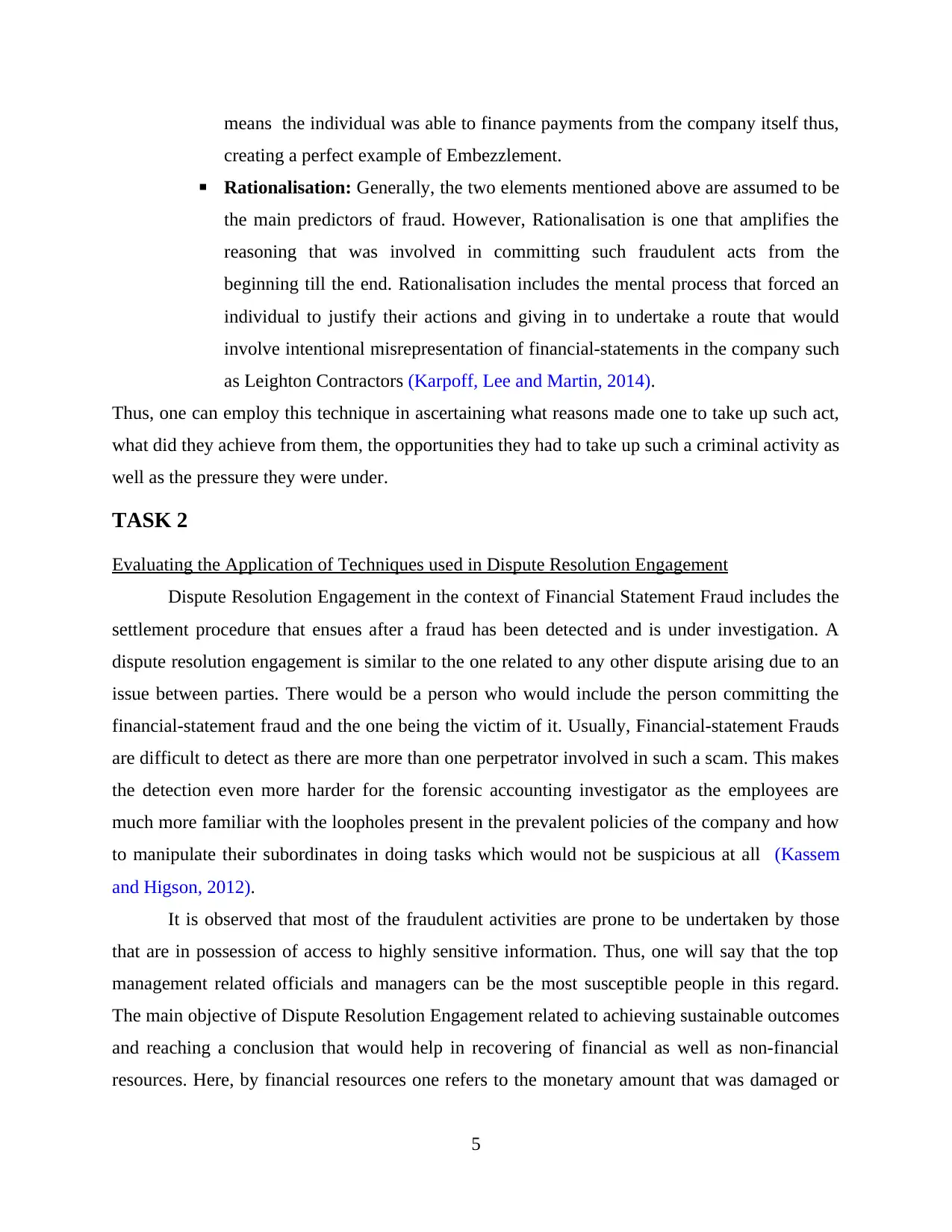
means the individual was able to finance payments from the company itself thus,
creating a perfect example of Embezzlement.
▪ Rationalisation: Generally, the two elements mentioned above are assumed to be
the main predictors of fraud. However, Rationalisation is one that amplifies the
reasoning that was involved in committing such fraudulent acts from the
beginning till the end. Rationalisation includes the mental process that forced an
individual to justify their actions and giving in to undertake a route that would
involve intentional misrepresentation of financial-statements in the company such
as Leighton Contractors (Karpoff, Lee and Martin, 2014).
Thus, one can employ this technique in ascertaining what reasons made one to take up such act,
what did they achieve from them, the opportunities they had to take up such a criminal activity as
well as the pressure they were under.
TASK 2
Evaluating the Application of Techniques used in Dispute Resolution Engagement
Dispute Resolution Engagement in the context of Financial Statement Fraud includes the
settlement procedure that ensues after a fraud has been detected and is under investigation. A
dispute resolution engagement is similar to the one related to any other dispute arising due to an
issue between parties. There would be a person who would include the person committing the
financial-statement fraud and the one being the victim of it. Usually, Financial-statement Frauds
are difficult to detect as there are more than one perpetrator involved in such a scam. This makes
the detection even more harder for the forensic accounting investigator as the employees are
much more familiar with the loopholes present in the prevalent policies of the company and how
to manipulate their subordinates in doing tasks which would not be suspicious at all (Kassem
and Higson, 2012).
It is observed that most of the fraudulent activities are prone to be undertaken by those
that are in possession of access to highly sensitive information. Thus, one will say that the top
management related officials and managers can be the most susceptible people in this regard.
The main objective of Dispute Resolution Engagement related to achieving sustainable outcomes
and reaching a conclusion that would help in recovering of financial as well as non-financial
resources. Here, by financial resources one refers to the monetary amount that was damaged or
5
creating a perfect example of Embezzlement.
▪ Rationalisation: Generally, the two elements mentioned above are assumed to be
the main predictors of fraud. However, Rationalisation is one that amplifies the
reasoning that was involved in committing such fraudulent acts from the
beginning till the end. Rationalisation includes the mental process that forced an
individual to justify their actions and giving in to undertake a route that would
involve intentional misrepresentation of financial-statements in the company such
as Leighton Contractors (Karpoff, Lee and Martin, 2014).
Thus, one can employ this technique in ascertaining what reasons made one to take up such act,
what did they achieve from them, the opportunities they had to take up such a criminal activity as
well as the pressure they were under.
TASK 2
Evaluating the Application of Techniques used in Dispute Resolution Engagement
Dispute Resolution Engagement in the context of Financial Statement Fraud includes the
settlement procedure that ensues after a fraud has been detected and is under investigation. A
dispute resolution engagement is similar to the one related to any other dispute arising due to an
issue between parties. There would be a person who would include the person committing the
financial-statement fraud and the one being the victim of it. Usually, Financial-statement Frauds
are difficult to detect as there are more than one perpetrator involved in such a scam. This makes
the detection even more harder for the forensic accounting investigator as the employees are
much more familiar with the loopholes present in the prevalent policies of the company and how
to manipulate their subordinates in doing tasks which would not be suspicious at all (Kassem
and Higson, 2012).
It is observed that most of the fraudulent activities are prone to be undertaken by those
that are in possession of access to highly sensitive information. Thus, one will say that the top
management related officials and managers can be the most susceptible people in this regard.
The main objective of Dispute Resolution Engagement related to achieving sustainable outcomes
and reaching a conclusion that would help in recovering of financial as well as non-financial
resources. Here, by financial resources one refers to the monetary amount that was damaged or
5
Paraphrase This Document
Need a fresh take? Get an instant paraphrase of this document with our AI Paraphraser
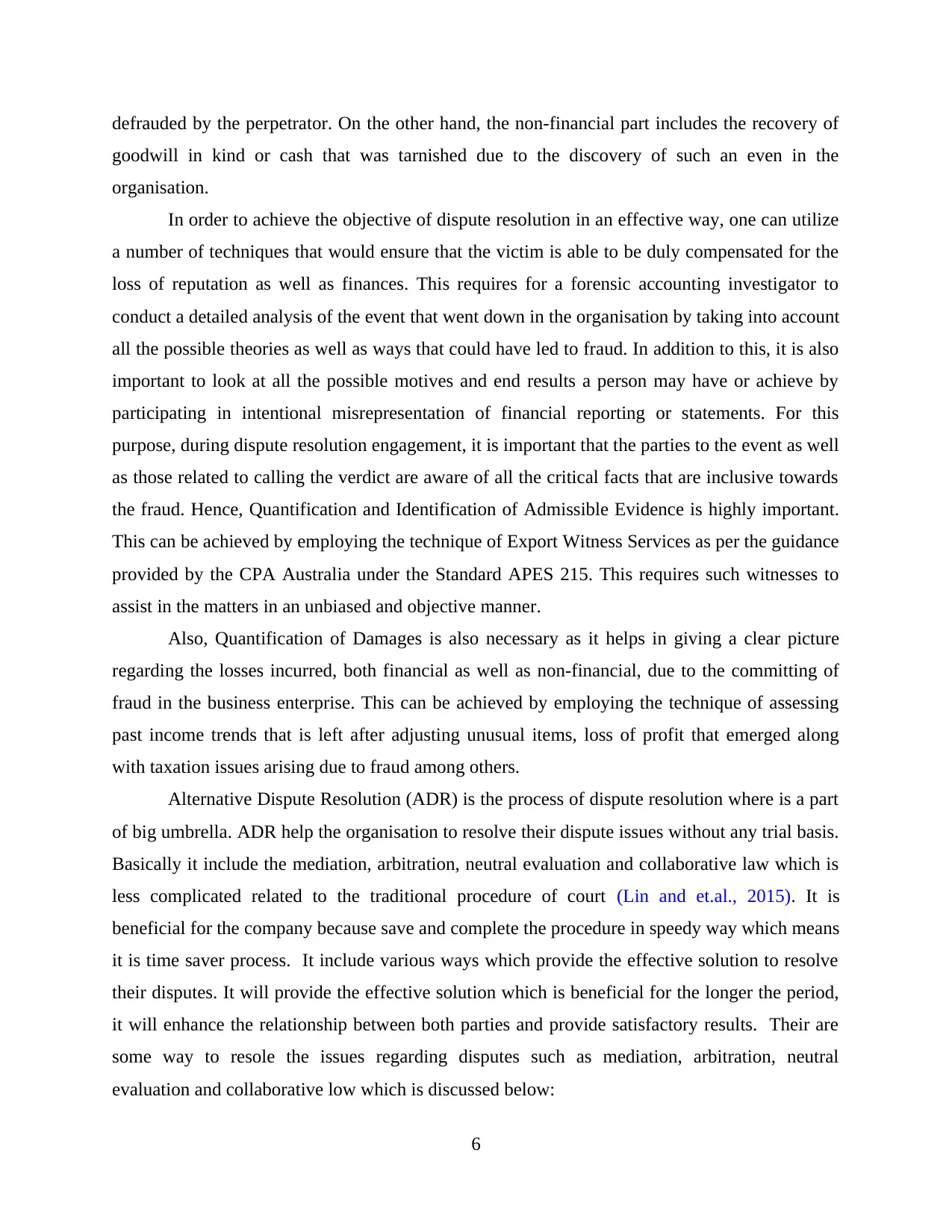
defrauded by the perpetrator. On the other hand, the non-financial part includes the recovery of
goodwill in kind or cash that was tarnished due to the discovery of such an even in the
organisation.
In order to achieve the objective of dispute resolution in an effective way, one can utilize
a number of techniques that would ensure that the victim is able to be duly compensated for the
loss of reputation as well as finances. This requires for a forensic accounting investigator to
conduct a detailed analysis of the event that went down in the organisation by taking into account
all the possible theories as well as ways that could have led to fraud. In addition to this, it is also
important to look at all the possible motives and end results a person may have or achieve by
participating in intentional misrepresentation of financial reporting or statements. For this
purpose, during dispute resolution engagement, it is important that the parties to the event as well
as those related to calling the verdict are aware of all the critical facts that are inclusive towards
the fraud. Hence, Quantification and Identification of Admissible Evidence is highly important.
This can be achieved by employing the technique of Export Witness Services as per the guidance
provided by the CPA Australia under the Standard APES 215. This requires such witnesses to
assist in the matters in an unbiased and objective manner.
Also, Quantification of Damages is also necessary as it helps in giving a clear picture
regarding the losses incurred, both financial as well as non-financial, due to the committing of
fraud in the business enterprise. This can be achieved by employing the technique of assessing
past income trends that is left after adjusting unusual items, loss of profit that emerged along
with taxation issues arising due to fraud among others.
Alternative Dispute Resolution (ADR) is the process of dispute resolution where is a part
of big umbrella. ADR help the organisation to resolve their dispute issues without any trial basis.
Basically it include the mediation, arbitration, neutral evaluation and collaborative law which is
less complicated related to the traditional procedure of court (Lin and et.al., 2015). It is
beneficial for the company because save and complete the procedure in speedy way which means
it is time saver process. It include various ways which provide the effective solution to resolve
their disputes. It will provide the effective solution which is beneficial for the longer the period,
it will enhance the relationship between both parties and provide satisfactory results. Their are
some way to resole the issues regarding disputes such as mediation, arbitration, neutral
evaluation and collaborative low which is discussed below:
6
goodwill in kind or cash that was tarnished due to the discovery of such an even in the
organisation.
In order to achieve the objective of dispute resolution in an effective way, one can utilize
a number of techniques that would ensure that the victim is able to be duly compensated for the
loss of reputation as well as finances. This requires for a forensic accounting investigator to
conduct a detailed analysis of the event that went down in the organisation by taking into account
all the possible theories as well as ways that could have led to fraud. In addition to this, it is also
important to look at all the possible motives and end results a person may have or achieve by
participating in intentional misrepresentation of financial reporting or statements. For this
purpose, during dispute resolution engagement, it is important that the parties to the event as well
as those related to calling the verdict are aware of all the critical facts that are inclusive towards
the fraud. Hence, Quantification and Identification of Admissible Evidence is highly important.
This can be achieved by employing the technique of Export Witness Services as per the guidance
provided by the CPA Australia under the Standard APES 215. This requires such witnesses to
assist in the matters in an unbiased and objective manner.
Also, Quantification of Damages is also necessary as it helps in giving a clear picture
regarding the losses incurred, both financial as well as non-financial, due to the committing of
fraud in the business enterprise. This can be achieved by employing the technique of assessing
past income trends that is left after adjusting unusual items, loss of profit that emerged along
with taxation issues arising due to fraud among others.
Alternative Dispute Resolution (ADR) is the process of dispute resolution where is a part
of big umbrella. ADR help the organisation to resolve their dispute issues without any trial basis.
Basically it include the mediation, arbitration, neutral evaluation and collaborative law which is
less complicated related to the traditional procedure of court (Lin and et.al., 2015). It is
beneficial for the company because save and complete the procedure in speedy way which means
it is time saver process. It include various ways which provide the effective solution to resolve
their disputes. It will provide the effective solution which is beneficial for the longer the period,
it will enhance the relationship between both parties and provide satisfactory results. Their are
some way to resole the issues regarding disputes such as mediation, arbitration, neutral
evaluation and collaborative low which is discussed below:
6
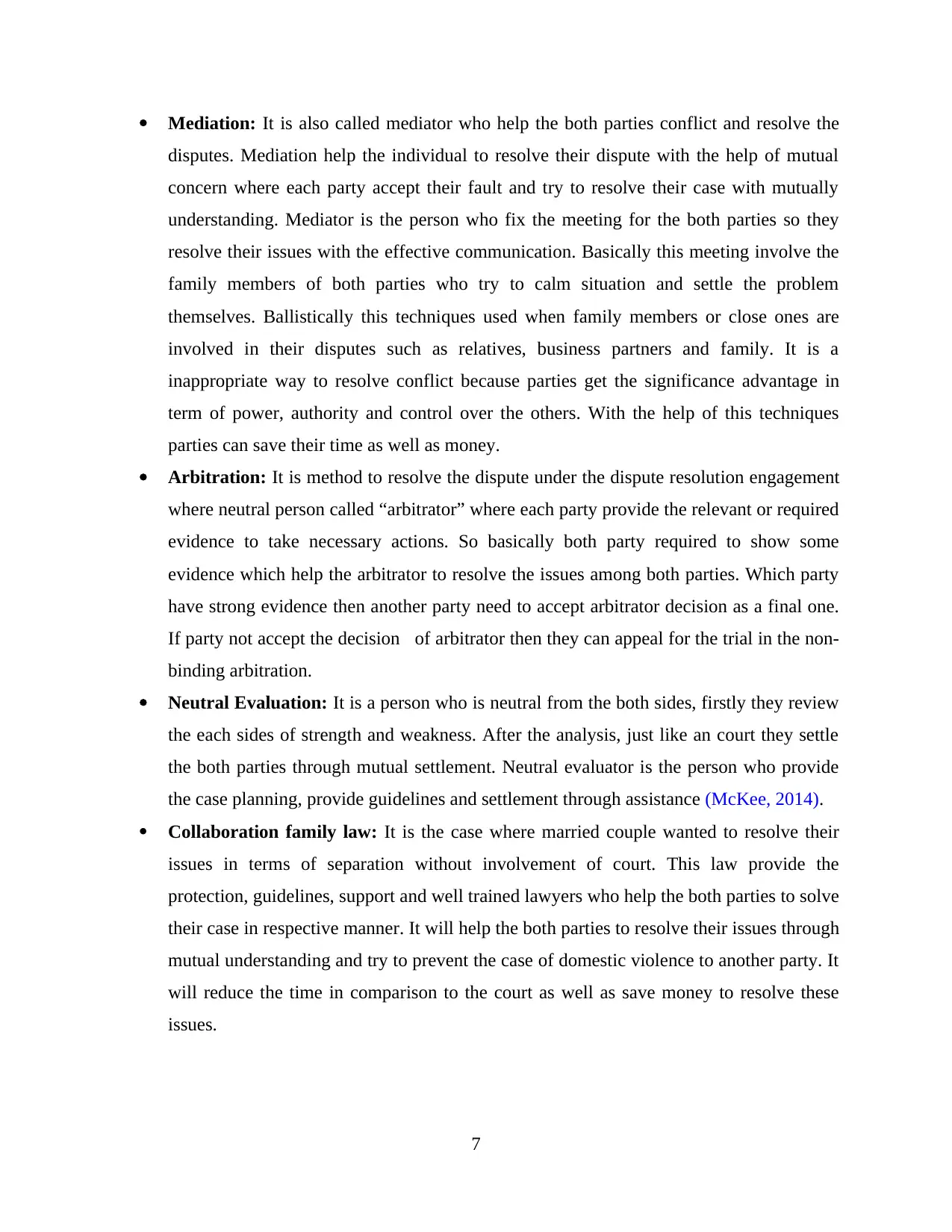
Mediation: It is also called mediator who help the both parties conflict and resolve the
disputes. Mediation help the individual to resolve their dispute with the help of mutual
concern where each party accept their fault and try to resolve their case with mutually
understanding. Mediator is the person who fix the meeting for the both parties so they
resolve their issues with the effective communication. Basically this meeting involve the
family members of both parties who try to calm situation and settle the problem
themselves. Ballistically this techniques used when family members or close ones are
involved in their disputes such as relatives, business partners and family. It is a
inappropriate way to resolve conflict because parties get the significance advantage in
term of power, authority and control over the others. With the help of this techniques
parties can save their time as well as money.
Arbitration: It is method to resolve the dispute under the dispute resolution engagement
where neutral person called “arbitrator” where each party provide the relevant or required
evidence to take necessary actions. So basically both party required to show some
evidence which help the arbitrator to resolve the issues among both parties. Which party
have strong evidence then another party need to accept arbitrator decision as a final one.
If party not accept the decision of arbitrator then they can appeal for the trial in the non-
binding arbitration.
Neutral Evaluation: It is a person who is neutral from the both sides, firstly they review
the each sides of strength and weakness. After the analysis, just like an court they settle
the both parties through mutual settlement. Neutral evaluator is the person who provide
the case planning, provide guidelines and settlement through assistance (McKee, 2014).
Collaboration family law: It is the case where married couple wanted to resolve their
issues in terms of separation without involvement of court. This law provide the
protection, guidelines, support and well trained lawyers who help the both parties to solve
their case in respective manner. It will help the both parties to resolve their issues through
mutual understanding and try to prevent the case of domestic violence to another party. It
will reduce the time in comparison to the court as well as save money to resolve these
issues.
7
disputes. Mediation help the individual to resolve their dispute with the help of mutual
concern where each party accept their fault and try to resolve their case with mutually
understanding. Mediator is the person who fix the meeting for the both parties so they
resolve their issues with the effective communication. Basically this meeting involve the
family members of both parties who try to calm situation and settle the problem
themselves. Ballistically this techniques used when family members or close ones are
involved in their disputes such as relatives, business partners and family. It is a
inappropriate way to resolve conflict because parties get the significance advantage in
term of power, authority and control over the others. With the help of this techniques
parties can save their time as well as money.
Arbitration: It is method to resolve the dispute under the dispute resolution engagement
where neutral person called “arbitrator” where each party provide the relevant or required
evidence to take necessary actions. So basically both party required to show some
evidence which help the arbitrator to resolve the issues among both parties. Which party
have strong evidence then another party need to accept arbitrator decision as a final one.
If party not accept the decision of arbitrator then they can appeal for the trial in the non-
binding arbitration.
Neutral Evaluation: It is a person who is neutral from the both sides, firstly they review
the each sides of strength and weakness. After the analysis, just like an court they settle
the both parties through mutual settlement. Neutral evaluator is the person who provide
the case planning, provide guidelines and settlement through assistance (McKee, 2014).
Collaboration family law: It is the case where married couple wanted to resolve their
issues in terms of separation without involvement of court. This law provide the
protection, guidelines, support and well trained lawyers who help the both parties to solve
their case in respective manner. It will help the both parties to resolve their issues through
mutual understanding and try to prevent the case of domestic violence to another party. It
will reduce the time in comparison to the court as well as save money to resolve these
issues.
7
⊘ This is a preview!⊘
Do you want full access?
Subscribe today to unlock all pages.

Trusted by 1+ million students worldwide
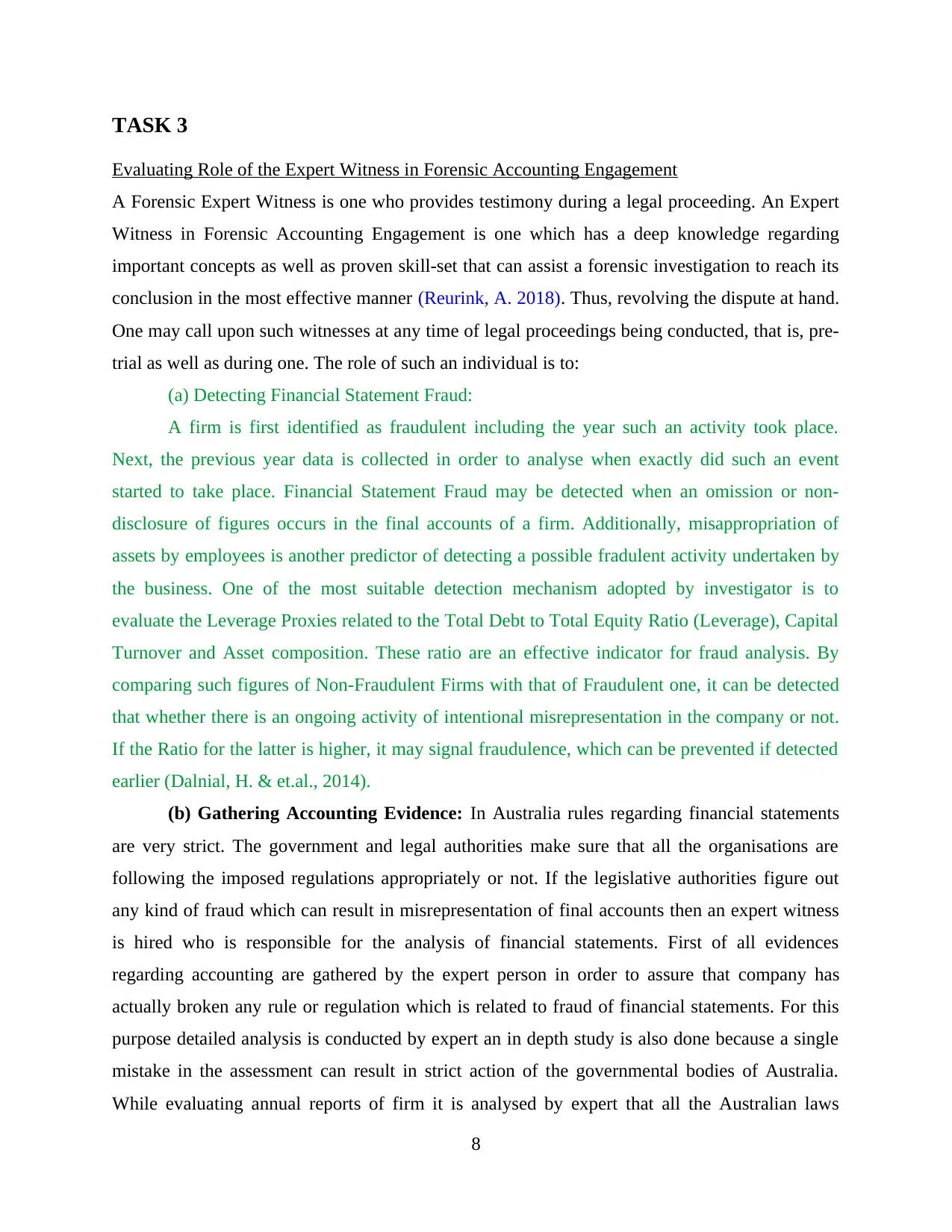
TASK 3
Evaluating Role of the Expert Witness in Forensic Accounting Engagement
A Forensic Expert Witness is one who provides testimony during a legal proceeding. An Expert
Witness in Forensic Accounting Engagement is one which has a deep knowledge regarding
important concepts as well as proven skill-set that can assist a forensic investigation to reach its
conclusion in the most effective manner (Reurink, A. 2018). Thus, revolving the dispute at hand.
One may call upon such witnesses at any time of legal proceedings being conducted, that is, pre-
trial as well as during one. The role of such an individual is to:
(a) Detecting Financial Statement Fraud:
A firm is first identified as fraudulent including the year such an activity took place.
Next, the previous year data is collected in order to analyse when exactly did such an event
started to take place. Financial Statement Fraud may be detected when an omission or non-
disclosure of figures occurs in the final accounts of a firm. Additionally, misappropriation of
assets by employees is another predictor of detecting a possible fradulent activity undertaken by
the business. One of the most suitable detection mechanism adopted by investigator is to
evaluate the Leverage Proxies related to the Total Debt to Total Equity Ratio (Leverage), Capital
Turnover and Asset composition. These ratio are an effective indicator for fraud analysis. By
comparing such figures of Non-Fraudulent Firms with that of Fraudulent one, it can be detected
that whether there is an ongoing activity of intentional misrepresentation in the company or not.
If the Ratio for the latter is higher, it may signal fraudulence, which can be prevented if detected
earlier (Dalnial, H. & et.al., 2014).
(b) Gathering Accounting Evidence: In Australia rules regarding financial statements
are very strict. The government and legal authorities make sure that all the organisations are
following the imposed regulations appropriately or not. If the legislative authorities figure out
any kind of fraud which can result in misrepresentation of final accounts then an expert witness
is hired who is responsible for the analysis of financial statements. First of all evidences
regarding accounting are gathered by the expert person in order to assure that company has
actually broken any rule or regulation which is related to fraud of financial statements. For this
purpose detailed analysis is conducted by expert an in depth study is also done because a single
mistake in the assessment can result in strict action of the governmental bodies of Australia.
While evaluating annual reports of firm it is analysed by expert that all the Australian laws
8
Evaluating Role of the Expert Witness in Forensic Accounting Engagement
A Forensic Expert Witness is one who provides testimony during a legal proceeding. An Expert
Witness in Forensic Accounting Engagement is one which has a deep knowledge regarding
important concepts as well as proven skill-set that can assist a forensic investigation to reach its
conclusion in the most effective manner (Reurink, A. 2018). Thus, revolving the dispute at hand.
One may call upon such witnesses at any time of legal proceedings being conducted, that is, pre-
trial as well as during one. The role of such an individual is to:
(a) Detecting Financial Statement Fraud:
A firm is first identified as fraudulent including the year such an activity took place.
Next, the previous year data is collected in order to analyse when exactly did such an event
started to take place. Financial Statement Fraud may be detected when an omission or non-
disclosure of figures occurs in the final accounts of a firm. Additionally, misappropriation of
assets by employees is another predictor of detecting a possible fradulent activity undertaken by
the business. One of the most suitable detection mechanism adopted by investigator is to
evaluate the Leverage Proxies related to the Total Debt to Total Equity Ratio (Leverage), Capital
Turnover and Asset composition. These ratio are an effective indicator for fraud analysis. By
comparing such figures of Non-Fraudulent Firms with that of Fraudulent one, it can be detected
that whether there is an ongoing activity of intentional misrepresentation in the company or not.
If the Ratio for the latter is higher, it may signal fraudulence, which can be prevented if detected
earlier (Dalnial, H. & et.al., 2014).
(b) Gathering Accounting Evidence: In Australia rules regarding financial statements
are very strict. The government and legal authorities make sure that all the organisations are
following the imposed regulations appropriately or not. If the legislative authorities figure out
any kind of fraud which can result in misrepresentation of final accounts then an expert witness
is hired who is responsible for the analysis of financial statements. First of all evidences
regarding accounting are gathered by the expert person in order to assure that company has
actually broken any rule or regulation which is related to fraud of financial statements. For this
purpose detailed analysis is conducted by expert an in depth study is also done because a single
mistake in the assessment can result in strict action of the governmental bodies of Australia.
While evaluating annual reports of firm it is analysed by expert that all the Australian laws
8
Paraphrase This Document
Need a fresh take? Get an instant paraphrase of this document with our AI Paraphraser
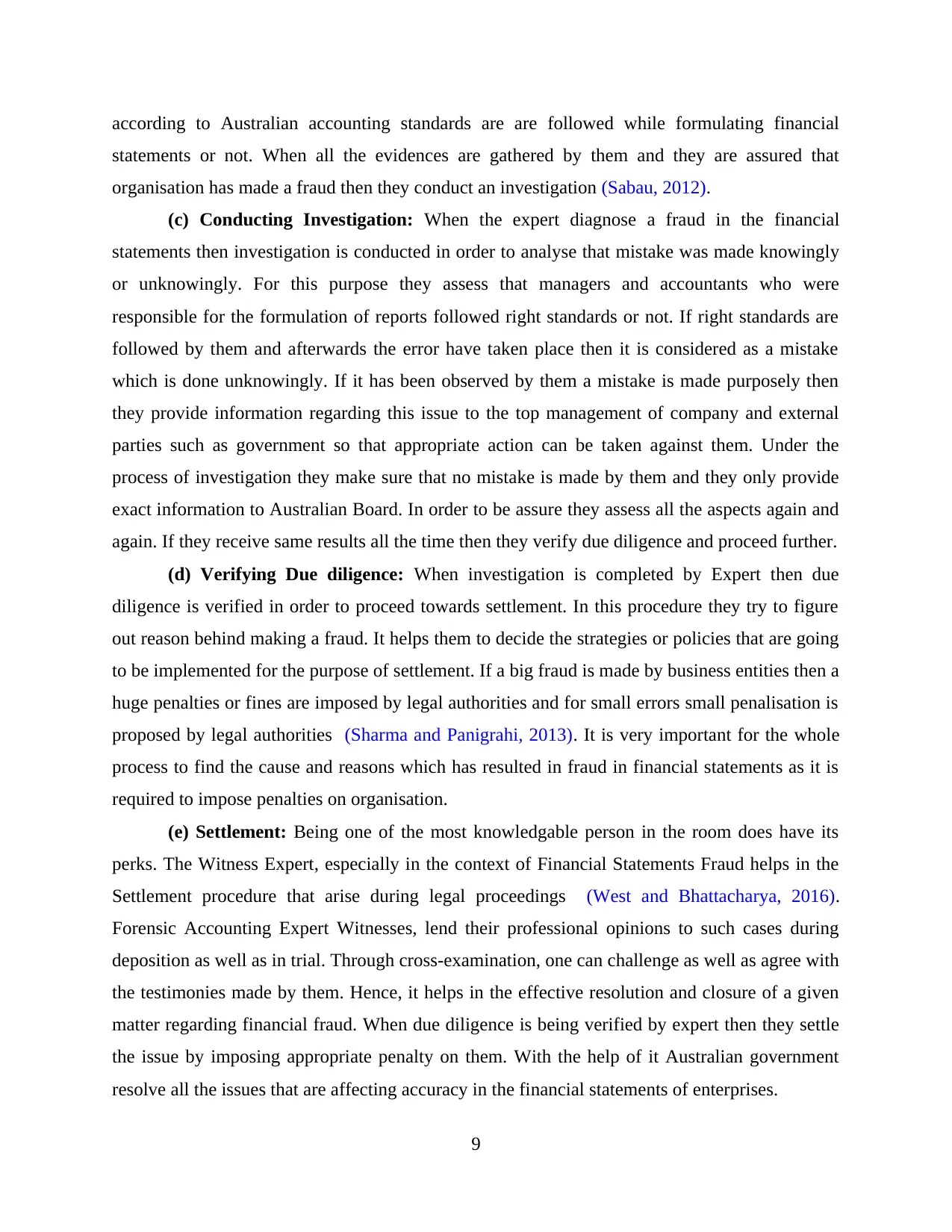
according to Australian accounting standards are are followed while formulating financial
statements or not. When all the evidences are gathered by them and they are assured that
organisation has made a fraud then they conduct an investigation (Sabau, 2012).
(c) Conducting Investigation: When the expert diagnose a fraud in the financial
statements then investigation is conducted in order to analyse that mistake was made knowingly
or unknowingly. For this purpose they assess that managers and accountants who were
responsible for the formulation of reports followed right standards or not. If right standards are
followed by them and afterwards the error have taken place then it is considered as a mistake
which is done unknowingly. If it has been observed by them a mistake is made purposely then
they provide information regarding this issue to the top management of company and external
parties such as government so that appropriate action can be taken against them. Under the
process of investigation they make sure that no mistake is made by them and they only provide
exact information to Australian Board. In order to be assure they assess all the aspects again and
again. If they receive same results all the time then they verify due diligence and proceed further.
(d) Verifying Due diligence: When investigation is completed by Expert then due
diligence is verified in order to proceed towards settlement. In this procedure they try to figure
out reason behind making a fraud. It helps them to decide the strategies or policies that are going
to be implemented for the purpose of settlement. If a big fraud is made by business entities then a
huge penalties or fines are imposed by legal authorities and for small errors small penalisation is
proposed by legal authorities (Sharma and Panigrahi, 2013). It is very important for the whole
process to find the cause and reasons which has resulted in fraud in financial statements as it is
required to impose penalties on organisation.
(e) Settlement: Being one of the most knowledgable person in the room does have its
perks. The Witness Expert, especially in the context of Financial Statements Fraud helps in the
Settlement procedure that arise during legal proceedings (West and Bhattacharya, 2016).
Forensic Accounting Expert Witnesses, lend their professional opinions to such cases during
deposition as well as in trial. Through cross-examination, one can challenge as well as agree with
the testimonies made by them. Hence, it helps in the effective resolution and closure of a given
matter regarding financial fraud. When due diligence is being verified by expert then they settle
the issue by imposing appropriate penalty on them. With the help of it Australian government
resolve all the issues that are affecting accuracy in the financial statements of enterprises.
9
statements or not. When all the evidences are gathered by them and they are assured that
organisation has made a fraud then they conduct an investigation (Sabau, 2012).
(c) Conducting Investigation: When the expert diagnose a fraud in the financial
statements then investigation is conducted in order to analyse that mistake was made knowingly
or unknowingly. For this purpose they assess that managers and accountants who were
responsible for the formulation of reports followed right standards or not. If right standards are
followed by them and afterwards the error have taken place then it is considered as a mistake
which is done unknowingly. If it has been observed by them a mistake is made purposely then
they provide information regarding this issue to the top management of company and external
parties such as government so that appropriate action can be taken against them. Under the
process of investigation they make sure that no mistake is made by them and they only provide
exact information to Australian Board. In order to be assure they assess all the aspects again and
again. If they receive same results all the time then they verify due diligence and proceed further.
(d) Verifying Due diligence: When investigation is completed by Expert then due
diligence is verified in order to proceed towards settlement. In this procedure they try to figure
out reason behind making a fraud. It helps them to decide the strategies or policies that are going
to be implemented for the purpose of settlement. If a big fraud is made by business entities then a
huge penalties or fines are imposed by legal authorities and for small errors small penalisation is
proposed by legal authorities (Sharma and Panigrahi, 2013). It is very important for the whole
process to find the cause and reasons which has resulted in fraud in financial statements as it is
required to impose penalties on organisation.
(e) Settlement: Being one of the most knowledgable person in the room does have its
perks. The Witness Expert, especially in the context of Financial Statements Fraud helps in the
Settlement procedure that arise during legal proceedings (West and Bhattacharya, 2016).
Forensic Accounting Expert Witnesses, lend their professional opinions to such cases during
deposition as well as in trial. Through cross-examination, one can challenge as well as agree with
the testimonies made by them. Hence, it helps in the effective resolution and closure of a given
matter regarding financial fraud. When due diligence is being verified by expert then they settle
the issue by imposing appropriate penalty on them. With the help of it Australian government
resolve all the issues that are affecting accuracy in the financial statements of enterprises.
9
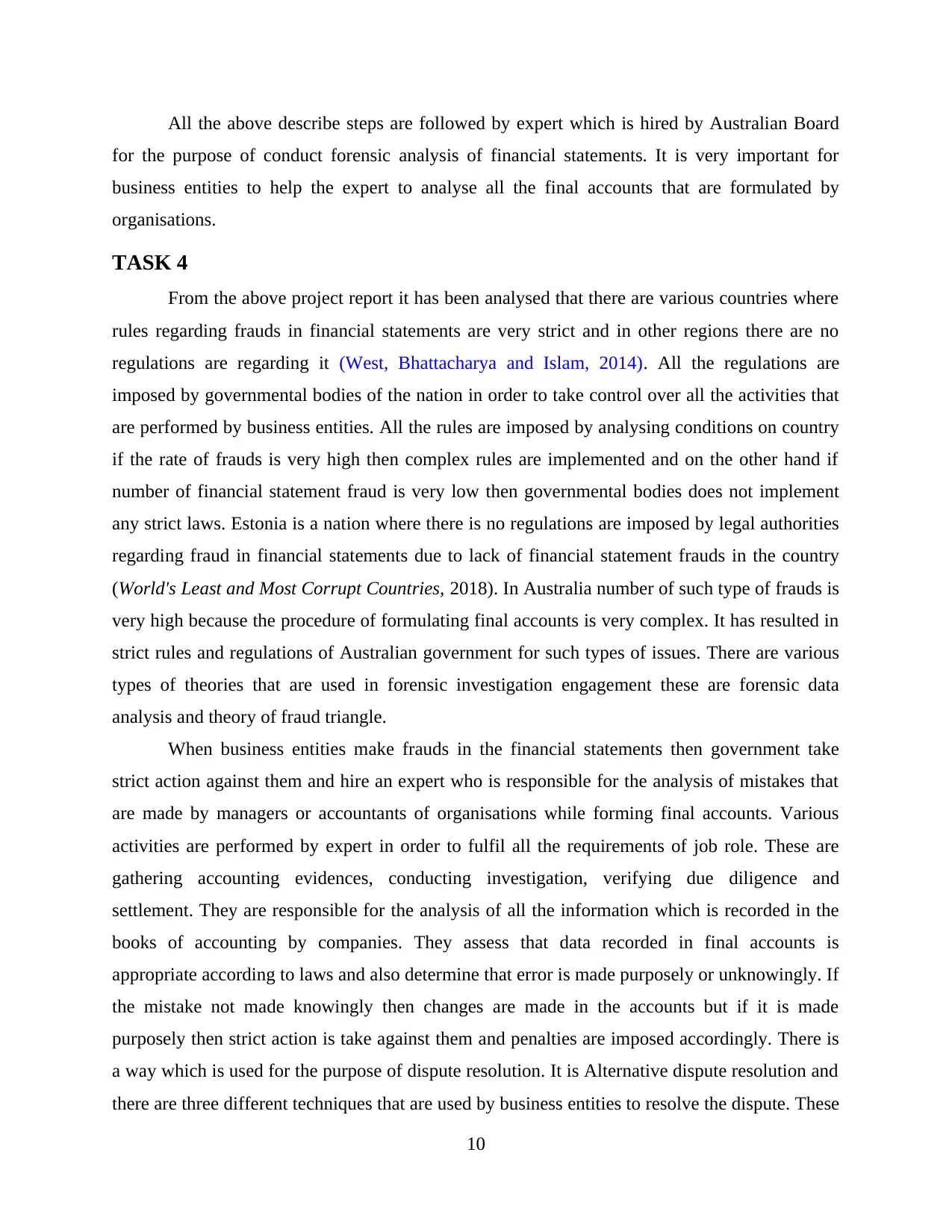
All the above describe steps are followed by expert which is hired by Australian Board
for the purpose of conduct forensic analysis of financial statements. It is very important for
business entities to help the expert to analyse all the final accounts that are formulated by
organisations.
TASK 4
From the above project report it has been analysed that there are various countries where
rules regarding frauds in financial statements are very strict and in other regions there are no
regulations are regarding it (West, Bhattacharya and Islam, 2014). All the regulations are
imposed by governmental bodies of the nation in order to take control over all the activities that
are performed by business entities. All the rules are imposed by analysing conditions on country
if the rate of frauds is very high then complex rules are implemented and on the other hand if
number of financial statement fraud is very low then governmental bodies does not implement
any strict laws. Estonia is a nation where there is no regulations are imposed by legal authorities
regarding fraud in financial statements due to lack of financial statement frauds in the country
(World's Least and Most Corrupt Countries, 2018). In Australia number of such type of frauds is
very high because the procedure of formulating final accounts is very complex. It has resulted in
strict rules and regulations of Australian government for such types of issues. There are various
types of theories that are used in forensic investigation engagement these are forensic data
analysis and theory of fraud triangle.
When business entities make frauds in the financial statements then government take
strict action against them and hire an expert who is responsible for the analysis of mistakes that
are made by managers or accountants of organisations while forming final accounts. Various
activities are performed by expert in order to fulfil all the requirements of job role. These are
gathering accounting evidences, conducting investigation, verifying due diligence and
settlement. They are responsible for the analysis of all the information which is recorded in the
books of accounting by companies. They assess that data recorded in final accounts is
appropriate according to laws and also determine that error is made purposely or unknowingly. If
the mistake not made knowingly then changes are made in the accounts but if it is made
purposely then strict action is take against them and penalties are imposed accordingly. There is
a way which is used for the purpose of dispute resolution. It is Alternative dispute resolution and
there are three different techniques that are used by business entities to resolve the dispute. These
10
for the purpose of conduct forensic analysis of financial statements. It is very important for
business entities to help the expert to analyse all the final accounts that are formulated by
organisations.
TASK 4
From the above project report it has been analysed that there are various countries where
rules regarding frauds in financial statements are very strict and in other regions there are no
regulations are regarding it (West, Bhattacharya and Islam, 2014). All the regulations are
imposed by governmental bodies of the nation in order to take control over all the activities that
are performed by business entities. All the rules are imposed by analysing conditions on country
if the rate of frauds is very high then complex rules are implemented and on the other hand if
number of financial statement fraud is very low then governmental bodies does not implement
any strict laws. Estonia is a nation where there is no regulations are imposed by legal authorities
regarding fraud in financial statements due to lack of financial statement frauds in the country
(World's Least and Most Corrupt Countries, 2018). In Australia number of such type of frauds is
very high because the procedure of formulating final accounts is very complex. It has resulted in
strict rules and regulations of Australian government for such types of issues. There are various
types of theories that are used in forensic investigation engagement these are forensic data
analysis and theory of fraud triangle.
When business entities make frauds in the financial statements then government take
strict action against them and hire an expert who is responsible for the analysis of mistakes that
are made by managers or accountants of organisations while forming final accounts. Various
activities are performed by expert in order to fulfil all the requirements of job role. These are
gathering accounting evidences, conducting investigation, verifying due diligence and
settlement. They are responsible for the analysis of all the information which is recorded in the
books of accounting by companies. They assess that data recorded in final accounts is
appropriate according to laws and also determine that error is made purposely or unknowingly. If
the mistake not made knowingly then changes are made in the accounts but if it is made
purposely then strict action is take against them and penalties are imposed accordingly. There is
a way which is used for the purpose of dispute resolution. It is Alternative dispute resolution and
there are three different techniques that are used by business entities to resolve the dispute. These
10
⊘ This is a preview!⊘
Do you want full access?
Subscribe today to unlock all pages.

Trusted by 1+ million students worldwide
1 out of 14
Related Documents
Your All-in-One AI-Powered Toolkit for Academic Success.
+13062052269
info@desklib.com
Available 24*7 on WhatsApp / Email
![[object Object]](/_next/static/media/star-bottom.7253800d.svg)
Unlock your academic potential
Copyright © 2020–2025 A2Z Services. All Rights Reserved. Developed and managed by ZUCOL.





